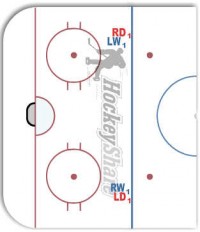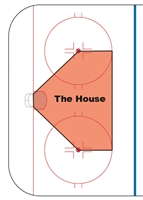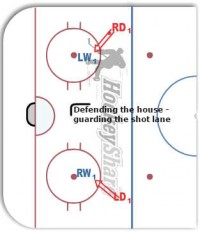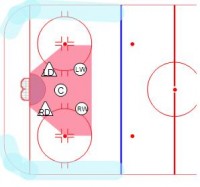“COVER YOUR POINT! COVER YOUR POINT!” I can still hear the cries of many a clueless teammates echo through the cavernous arena. We’ve all heard it. That’s because by some form of divine intervention, the hockey powers of beer league, while they can’t seem to keep guys from playing down 3 levels below their skill level, do manage to get at least one hockey know-it-all on every single beer league team. Just how exactly do they do that? Sorry, I digress.
Here is the situation: The puck is in your end of the ice, and you just can’t seem to get it out. Everyone is getting frustrated, and that’s when he starts his cry, most often from the bench: “Cover Your Point! Cover Your Point!” He’s yelling at one or both of his wingers, and he wants them to skate out to the blue line and cover the opposing team’s D-men. Well, Mr. Smarty-hockey-pants, I’ve been to a Weekend Warriors hockey camp, and I know better.
No, we are not suggesting that you let the opposing D have free rein to do whatever they want. Far from it. But we are saying that it is a big mistake to stand next to them and “guard” them like a cornerback guarding a wide receiver in football. Why is that? Doesn’t it make sense to “man up” and keep them from getting the puck? While it may seem like good logic, I will explain some errors in that thinking and then propose a better alternative.
 Mano y Mano a No-No
Mano y Mano a No-No
The thinking behind this strategy is that if each wing “guards” his point man, and prevents him from getting the puck, then those 2 point men will be effectively removed from the offense. Well maybe so, but consider the following points:
1) The ice rink is a large surface, and there is nothing anchoring those D men in one spot. All they have to do is slide 10 feet along the blue line, or 10 feet toward the net, getting themselves open for a quick pass and unobstructed shot.
2) In adult league hockey, wing is the position where we tend to “hide” our weaker skaters. And the other team is normally going to have at least one strong skater, possibly two, playing D. This means there is a good chance that at least one, if not both of our wings are going to be outmatched, and simply unable to adequately cover a better skater in this manner.
3) Even if both wingers do their job perfectly, this still creates a 3 on 3 down low. If the opposing forwards are any good, they will be moving around trying to create little 2 on 1 situations, which can give them a scoring opportunity from the dangerous areas of the ice.
OK, so what is a better way to defend?
 Defend the House
Defend the House
The cardinal rule in defensive hockey is to protect the house (see diagram), which is the most dangerous scoring area on the ice. So what we teach at Weekend Warriors camps is for the wingers to come down lower, positioning themselves from the middle to the top of the circles. But, you ask, doesn’t this leave the opposing D-men uncovered? Yes and no. Yes, they are more open for a pass from their teammates, but no, they are not uncovered. Let’s explore a little further.
If you are the defending winger, and the D-man on your point gets a puck, you immediately skate out at him…IN THE SHOT LANE. Even if you are a weaker skater defending a superstar, you are coming from the inside and expanding out. You are already in the shot lane. All you have to do is close the gap. So you face  him (your equipment offers the most protection from the front of your body) and skate toward him with your stick extended, blade on the ice. If you do this, chances are he is not going to shoot, as the option won’t look very good to him. And if he does, the most likely scenarios are that the puck goes up off your stick and into the corner or the netting, or better yet off your shin guard and out of the zone. And since you are skating up ice and he is following through on his shot, you’ve got quite a head start on a potential breakaway. The more likely scenario is that he is going to look to pass to one of his teammates. Job well done. If he does this, you can return to your position near the top of the circles.
him (your equipment offers the most protection from the front of your body) and skate toward him with your stick extended, blade on the ice. If you do this, chances are he is not going to shoot, as the option won’t look very good to him. And if he does, the most likely scenarios are that the puck goes up off your stick and into the corner or the netting, or better yet off your shin guard and out of the zone. And since you are skating up ice and he is following through on his shot, you’ve got quite a head start on a potential breakaway. The more likely scenario is that he is going to look to pass to one of his teammates. Job well done. If he does this, you can return to your position near the top of the circles.
Patience Grasshopper
So I’m going to anticipate an objection to this strategy. Someone is going to say, “but then he can just pass it to his teammate, and they are going to play keep away from us.” True, but so what? If the other winger and the other players on your team are doing their job of defending from the inside out, then they have the puck on the perimeter. Think about a basketball game where players are passing the ball around the perimeter looking for a chance to score. They probably want to get it to the inside for a scoring opportunity, but if they can get a good shooter open on the perimeter, he might take a shot. After all it’s worth 3 points, and oh yeah, there is no goalie. Well, there are no 3 point shots in hockey, and as Coach Kevin (Figsby) is fond of saying, “If they score from out there, we are going to get a new goalie.” Put another way, your goalie should stop all shots from the perimeter, provided they are not deflected in close. So let them have it out there. Make them pass it around the perimeter. Be patient and be disciplined. Think of it this way…every time they make a pass, it is an opportunity for a mistake. And you can increase the likelihood of a mistake by pressuring them quickly, and with an active stick. When they make that mistake, pounce on it and you’re on the attack!
Can I go lower?
OK, so we have given the defensive wingers permission to go as low as the hash marks (middle of your defensive faceoff circle), but can they go lower? You can watch an NHL game for an answer to this one. There are times when there are 7, 8, 9 or even 10 guys (think playoff time) in the paint or low slot battling for the puck. Why? Because that’s where the goal is. So yes, you can go down there to defend if there is a battle for the puck and you need to help out. Just don’t get caught way down low if the D-man you are responsible for is way up high. Otherwise you won’t be able to expand out at him quick enough to effectively influence his shot. And don’t go down low in the corners unless you are communicating a switch with one of your teammates. Otherwise you are leaving a giant opening that can be exploited. Your angle out of the corner is not one that will allow you to block or influence a shot on goal.
 Defend from the Inside Out
Defend from the Inside Out
Just to beat that horse one more time, let me point out that the concept we are really talking about here is more generically termed defending from the inside out. In other words, start from the house, and defend out from there. The goal is always in the same place, and they need to get the puck in there to score.
So the next time Mr. Smarty-hockey-pants tells you to Cover Your Point, you can explain to him that you are covering your point, just not the way he expects you to do it. And if that’s not good enough for him, then hand him a Weekend Warriors brochure, and we’ll be happy to explain it to him over the course of a fun-filled weekend of hockey learning and camaraderie.
